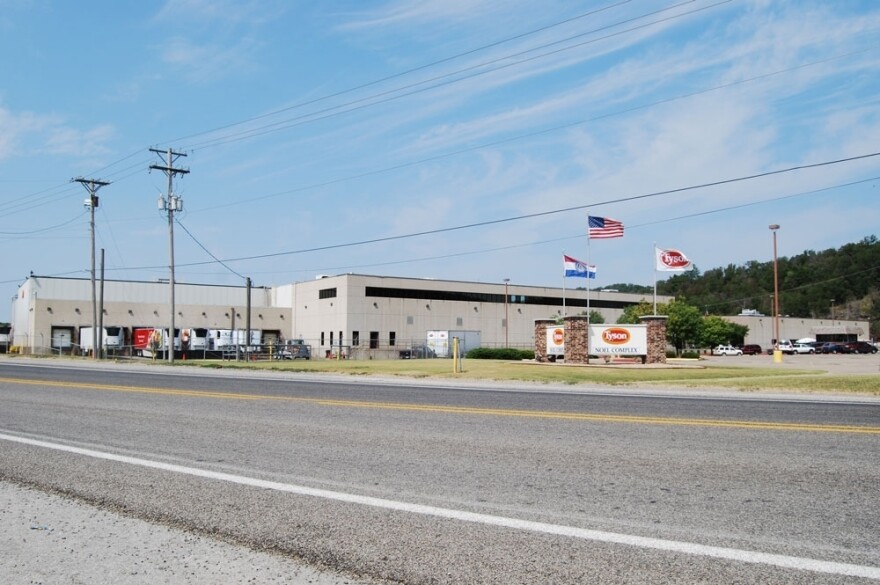Meat processing company Tyson Foods released at least 371.7 million pounds of pollution into U.S. waterways between 2018 and 2022, according to a from the Union of Concerned Scientists.
It’s the first time Tyson’s individual impact on the environment has been examined in this way, said Omanjana Goswami, one of the study’s authors. She said one of the goals of this study was to help consumers understand how major food companies with deep market penetration affect the environment.
“Companies like Tyson Foods have a massive hold on our farming system,” she said. “If you’ve bought chicken at the supermarket or if you’ve eaten nuggets at McDonalds, you’ve most likely been a consumer of Tyson Foods. It’s really hard to avoid.”
The analysis examines publicly available data on discharges from Tyson’s plants that have a National Pollution Discharge Elimination System permit from the U.S. Environmental Protection Agency, Goswami said. It identifies 30 pollutants released including chloride, nitrogen, phosphorus and a handful of other metals.
“There’s a long laundry list of pollutants that Tyson releases every year,” Goswami said.
Of the 371.7 million pounds of pollutants released, the study finds nitrogen accounted for 34.2 million pounds and phosphorus accounted for 5.1 million pounds. Both of these nutrients can harm plant and animal life in waterways .
On top of that, the majority of the pollutants released by Tyson in the five years the study examines were in the Midwestern states of Nebraska, Illinois and Missouri, she said. It’s a part of the country that already farms.
“You see a large part of the pollution is clustered around the ,” Goswami said. “Eventually, a lot of this flows into the Mississippi River, which then finds its way to the Gulf of Mexico, which then has this massive hypoxic dead zone.”
The dead zone in the Gulf of Mexico has been a . The overabundance of nutrients can starve aquatic life of oxygen, said Kelly McGinnis, executive director of the Mississippi River Network.
“Fish and things that can easily swim away are able to,” she said. “Shrimp and other invertebrates often aren’t.”
Upstream, nitrogen and phosphorus pollution can cause issues in local communities too, McGinnis said.
“If you live in a community that is having excessive nutrients, then your wastewater treatment plant is going to be working harder to treat that water,” she said.
Those who rely on well water may need to test it to ensure it’s safe to use, McGinnis said. Excessive nutrients in local waterways can also lead to harmful algal blooms, making them unsafe for recreation and even , she added.
Likely an undercount
While the report from the Union of Concerned Scientists identified hundreds of millions of pounds of pollution by Tyson, it’s not a complete look at the whole meat industry, or even all of Tyson’s operations. Goswami explained that’s because the group could not examine pollution data from smaller Tyson plants that don’t meet the threshold to require a NPDES permit from the EPA.
“Which means what they are releasing is going on unchecked in terms of both quantity of pollutants as well as category and type of pollutants,” she said. “And we are not able to capture that data.”
The EPA estimates about 300 of the 7,000 meat processing plants in the country need permits to discharge pollution, Goswami explained. She said because such a small number of plants are required to report, researchers are “looking at a scale of pollution whose ceiling we can’t quantify.”
McGinnis noted the report only examines meat processing facilities, which are one part of the meat supply chain.
“My mind could not help but make a connection to the concentrated animal feeding operations that are also operating in these same areas,” she said. “This report shows an astonishing impact on water quality by one company, and it seems there’s so much deeper we can go.”
A Tyson spokesperson said the company constantly monitors the wastewater coming from its facilities and works with federal and state regulators and local municipalities when planning and designing their discharge systems.
“Tyson Food uses a robust management system to mitigate environmental risks and impact, and we strive to run our operations as responsible stewards of our natural resources,” the spokesperson said. “This report does not acknowledge our ongoing compliance with EPA regulations and certification by the Water Alliance for our strong water management practices.”
The report does note the Tyson paid in 2018 for violating the Clean Water Act in Missouri and the over illegal wastewater discharge that killed hundreds of thousands of fish in Alabama. .
“When you’re able to have that kind of wealth concentrated in a company, they are not deterred by the fines that the current structure of the systems have in place,” McGinnis said. “We know there’s other large-scale companies like Tyson.”
The EPA is , particularly setting new rules for nitrogen and phosphorus, Goswami said.
“We’ve known, historically and based on the agenda that these companies have of prioritizing profit, that they’re most likely going to push back on regulations like this,” she said.
McGinnis agrees there needs to be more regulations in place but also argues large companies like Tyson need to shift how they consider and measure success.
“Climate change is only going to exacerbate the impacts of water pollution,” she said. “I think that means for a company like Tyson, are there other metrics of successful business besides just your profits?”
This © 2024 �������� story was shared via the network. The Ag & Water Desk is an editorially independent journalism collaborative that receives major funding from the Walton Family Foundation. The Mississippi River Network and Union of Concerned Scientists are also Walton grantees.






